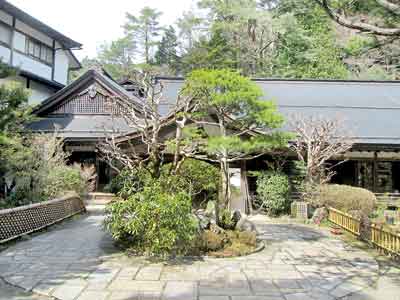On sacred ground at Japan’s centre of Shingon Buddhism

Inside Sanbo-in temple, Koya-san
Off the tourist circuit in Japan, a short train ride from the big city of Osaka, is one of the country’s most magical destinations – Koya-san or Koya Mountain.
The cedar-forested summit of this 850 metre high sacred mountain in Wakayama prefecture is home to over a hundred temples and monasteries. Established in 819 by monk Kobo Daishi Kukai, Koya-san is the headquarters of the Shingon school of Buddhism and is still considered one of the holiest places in this country. Any visitor to Japan would return from a visit to Koya-san not only with a greater understanding of Japanese culture and the Shingon school of Esoteric Buddhism but would also find the visit spiritually rewarding.
In the centre of Koya town is Kongobu-ji –the chief temple of the Shingon sect of Mahayana Buddhism. It was set up by Kobo Daishi in the ninth century following his return from China, where he learned from Master Huiguo, the eighth patriarch of Esoteric Buddhism. Bringing these teachings back to Japan he established the Shingon sect in that country.
Inside Kongobu-ji temple are exquisitely-painted sliding doors adorned with motifs of cranes and plum blossoms – and paintings depicting the story of Kobo Daishi’s journey to China and subsequent founding of the Koya-san monastery. Japan’s largest rock garden, Banryutei, is also situated within the Kongobu-ji temple complex.
A short walk from Kongobu-ji temple is another of Koya-san’s most sacred sites, the central temple complex of DanjoGaran. This is made up of about twenty structures, including the 45-metre tall Konpon Daito Pagoda and the large wooden Kondo Hall, where traditional ceremonies are performed.
Perhaps Koya-san’s most famous landmark is the largest cemetery in Japan, the revered Okunoin Cemetery, sacred because it contains tombstones from centuries past. The path into Okunoin goes over Ichi-no-hashi (“The first bridge”) into this surreal wooded sanctuary where even the air seems different. Tall cedar trees hide the sky, allowing the morning sun to just filter through. The very atmosphere feels sacred. You can stroll along the two kilometre paved road through the cemetery, pausing awhile to ponder on the cenotaphs and moss covered gravestones – memorials to feudal lords, religious leaders, military heroes, business leaders as well as nuns, monks, householders, children and even pets.
There are memorials here to soldiers who died in conflict – not just glorifying the Japanese war dead, but honouring those who died on both sides. The memorial to soldiers who perished in Borneo during the Second World War is identifiable by the three flags of Japan, Malaysia and Australia mounted on it. Another memorial pays homage to those warriors of both sides who died in the Japanese invasion of Korea in the last decade of the sixth century.
At the end of the walking path you come to the Torodo Hall (Hall of Lamps), a fairyland of more than 10,000 lanterns that have been donated by worshippers and are kept lit day and night. Beyond the Toro Hall is Kobo Daishi’s mausoleum.
While it is possible to do a day trip to Koya-san, I recommend spending a night here and staying in one of the temples called shukubo that offer accommodation for guests.
Although it is not the same as staying in a hotel with mod-cons, the experience of a temple lodging in sacred Koya-san is very worthwhile, affording you the opportunity of interacting with the resident monks, enjoying shojinryori (traditional Buddhist vegetarian meals) and even participating, if you wish, in some of the temple rituals.
There are several shukubo where you can pre-book accommodation. We stayed in Sanbo-in – where we discovered in the visitors’ hall a framed photo of former President JR Jayawardene taken when he visited Koya-san! Another well reputed shukubo is Eko-in which is quite conveniently close to the Okunoin. They even offer a night tour of the cemetery!
The best way to get to Koya-san is from Osaka’s Namba station – the Nankai Electric Railway runs express trains at half hourly intervals that take about two hours to the terminus at Gokurakubashi Station, from where the Koya Cable Car takes you to the top of the mountain. From here, a ten minute bus ride takes you into the centre of Koya town.
Sri Lankans would do well to visit in the period between late spring and early autumn (March to September) because winters can get quite cold here. Of course, winter brings snowfalls – so that braving the cold is a price worth paying if one wants to appreciate Koya-san’s beautiful snow-covered landscape.


